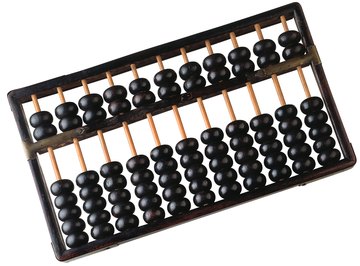
As architect Louis Sullivan once said, "Form ever follows function." The earliest stand-alone calculators were dedicated to the mathematics of trade -- addition, subtraction, multiplication, division. Later stand-alone calculators, such as the slide rule of the early and middle 20th century, required specialized training to operate. The hand-held electronic calculator of the 1960s and its descendant, the pocket calculator, continued the tradition of a self-contained calculator.
The Abacus
The abacus -- beads on a series of wires -- may be the earliest stand alone calculator. The operator moved the beads along the wires to a position against the frame or the divider in the middle of the frame. With 13 wires holding five beads each, the abacus provides a skilled operator with the ability to add, subtract, multiply or divide numbers up to the billions.
The Slide Rule
The slide rule of past generations used the principal of the abacus, but its form was that of a ruler, with a slide in the center, corresponding to the wires of the abacus, and a sliding magnifier to view the results. By moving the slide, you changed the physical relationship between the numbers printed on it and the numbers printed on the body of the "ruler." As with the abacus, you could perform addition, subtraction, multiplication or division. You could also perform more complex calculations, all with nothing more than the slide rule.
Electronic Calculators
The first electronic calculators appeared on store shelves in about 1966. By 1969, units with integrated circuits had begun to replace the earlier, more costly calculators and by the early 1970s, prices had dropped below $100. Prices continued to drop until, by 2011, a "pocket calculator" cost as little as $2.00. As prices fell, features were added, giving the user the ability to perform complex mathematical calculations and a display that showed graphic results of those calculations.
The Rise of the Machines
With the proliferation of wireless hot spots and smartphones, the line may blur between stand-alone calculators and calculators that are part of a computer. The "Mathematica," produced by Wolfram Research, is said to be the world's most expensive calculator. Mathematica isn't a stand-alone calculator, however. It uses a wireless device as simple as a cell phone or a notebook computer where it resides as an app. The user interface interacts with more powerful computers at Wolfram Research through a wireless service. While stand-alone calculators don't offer Mathematica's features, they don't require its tether to another source of information. The key to the stand-alone calculator's description is that it is independent of other devices and requires only an operator to fulfill its function.
References
About the Author
Will Charpentier is a writer who specializes in boating and maritime subjects. A retired ship captain, Charpentier holds a doctorate in applied ocean science and engineering. He is also a certified marine technician and the author of a popular text on writing local history.
Photo Credits
Brand X Pictures/Brand X Pictures/Getty Images
